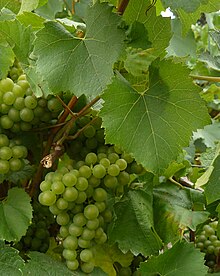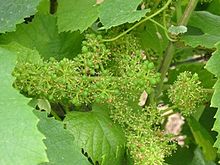
Chardonnay is a green-skinned grape variety used in the production of white wine. The variety originated in the Burgundy wine region of eastern France, but is now grown wherever wine is produced, from England to New Zealand. For new and developing wine regions, growing Chardonnay is seen as a 'rite of passage' and an easy entry into the international wine market.

Pinot blanc is a white wine grape. It is a point genetic mutation of Pinot noir. Pinot noir is genetically unstable and will occasionally experience a point mutation in which a vine bears all black fruit except for one cane which produces white fruit.

Folle blanche, also known as Picpoule, Gros Plant, and Enrageat blanc, is a wine grape variety from southwest France. It was the traditional grape variety in Cognac and Armagnac production until the 20th century. Folle blanche is an offspring of Gouais blanc, with the other parent so far unidentified.

Muscadet is a French white wine. It is made at the western end of the Loire Valley, near the city of Nantes in the Pays de la Loire region. It is made from the Melon de Bourgogne grape, often referred to simply as melon. While most appellation d'origine contrôlée wines are named after their growing region, or in Alsace after their variety, the name Muscadet refers to an alleged characteristic of the wine produced by the melon grape variety: vin qui a un goût musqué. However, according to wine expert Tom Stevenson, Muscadet wines do not have much, if any, muskiness or Muscat-like flavors or aromas.

Gouais blanc or Weißer Heunisch is a white grape variety that is seldom grown today but is important as the ancestor of many traditional French and German grape varieties. The name Gouais derives from the old French adjective ‘gou’, a term of derision befitting its traditional status as the grape of the peasants. Likewise, the German name Weißer Heunisch labels it as one of the lesser "Hunnic" grapes.
Romorantin is a traditional French variety of white wine grape, that is a sibling of Chardonnay. Once quite widely grown in the Loire, it has now only seen in the Cour-Cheverny AOC. It produces intense, minerally wines somewhat reminiscent of Chablis.
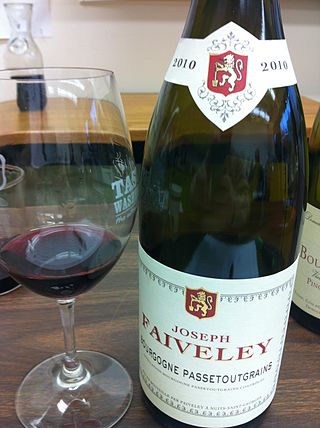
Bourgogne Passe-Tout-Grains is an Appellation d'origine contrôlée (AOC) for wine from the region of Burgundy in France. Most Bourgogne Passe-Tout-Grains, which is sometimes written unhyphenated as Bourgogne Passetoutgrains, is red although rosé wine may also be produced. Unlike other Burgundy wines, which are primarily produced from a single grape variety, Bourgogne Passe-Tout-Grains is essentially a cuvée of Gamay and Pinot noir.
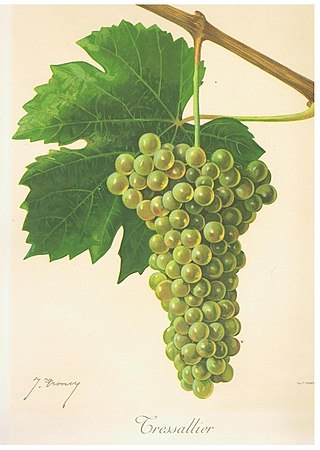
Sacy is a white wine grape grown primarily in the central and northeastern France within the Yonne and Allier départments.

Auxerrois blanc or Auxerrois Blanc de Laquenexy is a white wine grape that is important in Alsace, and is also grown in Germany and Luxembourg. It is a full sibling of Chardonnay that is often blended with the similar Pinot blanc.
Bachet noir is a traditional French variety of red wine grape that is a sibling of Chardonnay. A little is still grown in the Aube, where it is used to add colour and body to Gamay wines.

Beaunoir is a traditional French variety of red wine grape that is a sibling of Chardonnay. The 'beautiful black' grape produces a thin wine and not much is grown these days.
Franc Noir de la Haute-Saône is a traditional French variety of red wine grape that is a sibling of Chardonnay. It makes thin, tart wine and has largely disappeared from cultivation.
Gamay Blanc Gloriod is an obscure French variety of white wine grape. Very little of it is grown commercially.
Knipperlé is a traditional French variety of white wine grape from Alsace. It's not listed for use in AOC wine, but is a minor component of blends for local drinking, in some ways an Alsatian equivalent of its sibling Aligoté in Burgundy.
Peurion is a traditional French variety of white wine grape that is a sibling of Chardonnay. Once quite popular, not much is still grown in France these days.
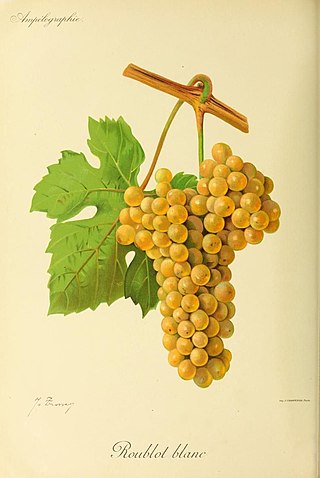
Roublot is a traditional French variety of white wine grape that is a sibling of Chardonnay. It was once quite widely grown near Auxerre.
Dameron is a traditional French variety of red wine grape that is a sibling of Gamay. Its wines are somewhat weightier than Gamay, but it is disappearing from its traditional areas in northern France. Not much is grown in France these days.

The Loire Valley wine region includes the French wine regions situated along the river Loire from the Muscadet region near the city of Nantes on the Atlantic coast to the region of Sancerre and Pouilly-Fumé just southeast of the city of Orléans in north central France. In between are the regions of Anjou wine, Saumur, Bourgueil, Chinon, and Vouvray. The Loire Valley itself follows the river through the Loire department to the river's origins in the Cévennes but the majority of the wine production takes place in the regions noted above. The area includes 87 appellations under the Appellation d'origine contrôlée (AOC), Vin Délimité de Qualité Superieure (VDQS) and Vin de pays systems. While the majority of production is white wine from the Chenin blanc, Sauvignon blanc and Melon de Bourgogne grapes, there are red wines made from Cabernet franc. In addition to still wines, rosé, sparkling and dessert wines are also produced. With Crémant production throughout the Loire, it is the second largest sparkling wine producer in France after Champagne. Among these different wine styles, Loire wines tend to exhibit characteristic fruitiness with fresh, crisp flavors-especially in their youth. The Loire Valley has a long history of winemaking dating back to the 1st century. In the High Middle Ages, the wines of the Loire Valley were the most esteemed wines in England and France, even more prized than those from Bordeaux.
Pierre Galet was a French ampelographer and author who was an influential figure within ampelography in the 20th century and before DNA typing was widely introduced. Beginning in the 1950s, Pierre Galet introduced a system for identifying varieties based on the shape, contours and characteristics of the leaves of the vines, petioles, growing shoots, shoot tips, grape clusters, as well as the colour, size, seed content and flavour of the grapes. The impact and comprehensiveness of his work earned him the consideration as the "father of modern ampelography". He started publishing within ampelography in the 1950s and his Ph.D. thesis was presented in 1967. He has also written popular science books on grape varieties. Galet was active at the École Nationale Supérieure Agronomique de Montpellier.
Aubin vert is a white French wine grape variety that is grown in the Lorraine region where it is an authorized variety for the Appellation d'Origine Contrôlée (AOC) wines of the Moselle. While often confused for the Côtes de Toul grape Aubin blanc, DNA analysis in 1999 showed that Aubin vert was the result of a crossing of Gouais blanc with Pinot. This makes the grape a half-sibling to Aubin blanc but full sibling to Chardonnay, Aligoté, Gamay and Melon de Bourgogne.
